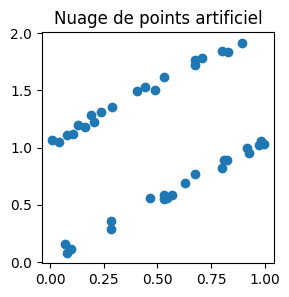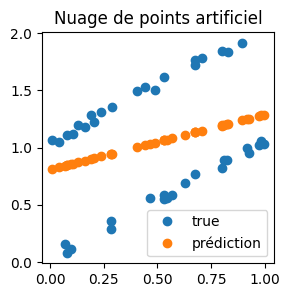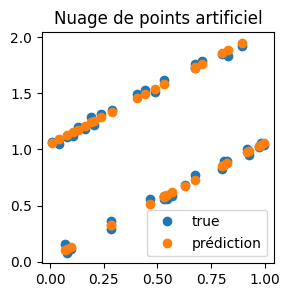Plusieurs modèles, données disjointes¶
On cherche à prédire la note d’un vin mais on suppose que cette qualité est dépendante de la couleur et qu’il faudrait appliquer des modèles différents selon la couleur.
[2]:
%matplotlib inline
données¶
[1]:
from teachpyx.datasets import load_wines_dataset
df = load_wines_dataset()
[3]:
X = df.drop(["quality", "color"], axis=1)
y = df["quality"]
color = df["color"]
[4]:
from sklearn.model_selection import train_test_split
X_train, X_test, y_train, y_test, color_train, color_test = train_test_split(
X, y, color
)
version manuelle¶
On cale d’abord un modèle linéaire sur toute la base.
[5]:
from sklearn.linear_model import LogisticRegression
clr = LogisticRegression()
clr.fit(X_train, y_train)
~/install/scikit-learn/sklearn/linear_model/_logistic.py:474: ConvergenceWarning: lbfgs failed to converge (status=1):
STOP: TOTAL NO. of ITERATIONS REACHED LIMIT.
Increase the number of iterations (max_iter) or scale the data as shown in:
https://scikit-learn.org/stable/modules/preprocessing.html
Please also refer to the documentation for alternative solver options:
https://scikit-learn.org/stable/modules/linear_model.html#logistic-regression
n_iter_i = _check_optimize_result(
[5]:
LogisticRegression()In a Jupyter environment, please rerun this cell to show the HTML representation or trust the notebook.
On GitHub, the HTML representation is unable to render, please try loading this page with nbviewer.org.
LogisticRegression()
[6]:
from sklearn.metrics import accuracy_score
accuracy_score(y_test, clr.predict(X_test))
[6]:
0.4793846153846154
Et maintenant on essaye de caler un modèle différent selon les couleurs.
[7]:
X_train_white = X_train[color_train == "white"]
y_train_white = y_train[color_train == "white"]
X_train_red = X_train[color_train == "red"]
y_train_red = y_train[color_train == "red"]
[8]:
clr_white = LogisticRegression()
clr_white.fit(X_train, y_train)
clr_red = LogisticRegression()
clr_red.fit(X_train_red, y_train_red)
~/install/scikit-learn/sklearn/linear_model/_logistic.py:474: ConvergenceWarning: lbfgs failed to converge (status=1):
STOP: TOTAL NO. of ITERATIONS REACHED LIMIT.
Increase the number of iterations (max_iter) or scale the data as shown in:
https://scikit-learn.org/stable/modules/preprocessing.html
Please also refer to the documentation for alternative solver options:
https://scikit-learn.org/stable/modules/linear_model.html#logistic-regression
n_iter_i = _check_optimize_result(
~/install/scikit-learn/sklearn/linear_model/_logistic.py:474: ConvergenceWarning: lbfgs failed to converge (status=1):
STOP: TOTAL NO. of ITERATIONS REACHED LIMIT.
Increase the number of iterations (max_iter) or scale the data as shown in:
https://scikit-learn.org/stable/modules/preprocessing.html
Please also refer to the documentation for alternative solver options:
https://scikit-learn.org/stable/modules/linear_model.html#logistic-regression
n_iter_i = _check_optimize_result(
[8]:
LogisticRegression()In a Jupyter environment, please rerun this cell to show the HTML representation or trust the notebook.
On GitHub, the HTML representation is unable to render, please try loading this page with nbviewer.org.
LogisticRegression()
[9]:
X_test_white = X_test[color_test == "white"]
y_test_white = y_test[color_test == "white"]
X_test_red = X_test[color_test == "red"]
y_test_red = y_test[color_test == "red"]
[10]:
acc_white = accuracy_score(y_test_white, clr_white.predict(X_test_white))
acc_red = accuracy_score(y_test_red, clr_red.predict(X_test_red))
acc_white, acc_red
[10]:
(0.47843775427176566, 0.5984848484848485)
Il faut agréger pour obtenir les performances sur la base complète.
[11]:
acc2 = (acc_white * len(y_test_white) + acc_red * len(y_test_red)) / len(y_test)
acc2
[11]:
0.5076923076923077
C’est un petit peu mieux mais l’ensemble est compliqué à mettre en place. Il serait plus simple d’automatiser pour pouvoir faire de la validation croisée.
Automatisation¶
Au début, j’avais pensé écrire une classe inspirée de l’API de scikit-learn qui apprend plusieurs modèles selon une catégorie indiquée lors de l’apprentissage et de la prédiction.
[15]:
class SkLearnerCategory:
def fit(X, y, cat):
# ...
pass
def predict(X, cat):
# ...
pass
Mais à moins de changer l’interface des pipeline, il n’y aucun chance pour que cette classe puisse en faire partie. J’ai donc opté pour le design suivant même s’il ne me plaît que moyennement parce qu’il faut gérer plusieurs containers différents (numpy, pandas, …)
[16]:
class SkLearnerCategory:
def __init__(cat="column"):
self.cat_col = cat
pass
def fit(X, y, cat):
X = X.drop(self.cat_col, axis=1)
# ...
def predict(X, cat):
X = X.drop(self.cat_col, axis=1)
# ...
Bref, ça marche…
[22]:
import numpy
import pandas
from sklearn.base import BaseEstimator, ClassifierMixin, clone
class SkLearnerCategory(BaseEstimator, ClassifierMixin):
def __init__(self, colnameind=None, model=None):
assert isinstance(
colnameind, (int, str)
), f"colnameind must be str or int not {type(colnameind)}"
assert model is not None, "model must not be None"
self.model = model
self.colnameind = colnameind
def _get_cat(self, X):
"""
Retourne les catégories indiquées par *colnameind*.
"""
if isinstance(self.colnameind, str):
assert hasattr(
X, "columns"
), "colnameind='{0}' and X is not a DataFrame but {1}".format(
self.colnameind, type(X)
)
return X[self.colnameind]
return X[:, self.colnameind]
def _filter_cat(self, c, X, y=None, sample_weight=None):
"""
Retoure *X*, *y*, *sample_weight* pour la categorie *c* uniquement.
"""
indices = numpy.arange(0, X.shape[0])
if isinstance(self.colnameind, str):
assert hasattr(
X, "columns"
), "colnameind='{0}' and X is not a DataFrame but {1}".format(
self.colnameind, type(X)
)
ind = X[self.colnameind] == c
sa = None if sample_weight is None else sample_weight[ind]
y = None if y is None else y[ind]
ind, x = indices[ind], X.drop(self.colnameind, axis=1)[ind]
elif hasattr(X, "iloc"):
ind = X[self.colnameind] == c
sa = None if sample_weight is None else sample_weight[ind]
y = None if y is None else y[ind]
ind, x = indices[ind], X.iloc[ind, -self.colnameind]
else:
ind = X[self.colnameind] == c
sa = None if sample_weight is None else sample_weight[ind]
y = None if y is None else y[ind]
ind, x = indices[ind], X[ind, -self.colnameind]
assert y is None or x.shape[0] == y.shape[0], (
"Input arrays have different shapes for value='{0}': {1} != {2} "
"(expected: {3}) type(X)={4}".format(
c, X.shape[0], y.shape[0], ind.shape, type(X)
)
)
assert sa is None or x.shape[0] == sa.shape[0], (
"Input arrays have different shapes for value='{0}': {1} != {2} "
"(expected: {3}) type(X)={4}".format(
c, X.shape[0], sa.shape[0], ind.shape, type(X)
)
)
return ind, x, y, sa
###################
# API scikit-learn
###################
def fit(self, X, y=None, sample_weight=None, **kwargs):
cats = set(self._get_cat(X))
for c in cats:
if not isinstance(c, str) and numpy.isnan(c):
raise ValueError( # pragma: no cover
"One of the row has a missing category."
)
res = {}
for c in sorted(cats):
_, xcat, ycat, scat = self._filter_cat(c, X, y, sample_weight)
mod = clone(self.model)
if scat is not None:
kwargs["sample_weight"] = scat
mod.fit(xcat, ycat, **kwargs)
res[c] = mod
self.models = res
return self
def _any_predict(self, X, fct, *args):
"""
Prédit en appelant le modèle associé à chaque catégorie.
"""
cats = set(self._get_cat(X))
for c in cats:
if not isinstance(c, str) and numpy.isnan(c):
raise NotImplementedError( # pragma: no cover
"No default value is implemented in case of missing value."
)
res = []
for c in sorted(cats):
ind, xcat, ycat, _ = self._filter_cat(c, X, *args)
mod = self.models[c]
meth = getattr(mod, fct)
if ycat is None:
pred = meth(xcat)
else:
pred = meth(xcat, ycat)
if len(pred.shape) == 1:
pred = pred[:, numpy.newaxis]
if len(ind.shape) == 1:
ind = ind[:, numpy.newaxis]
pred = numpy.hstack([pred, ind])
res.append(pred)
try:
final = numpy.vstack(res)
except ValueError: # pragma: no cover
# Only one dimension.
final = numpy.hstack(res)
df = pandas.DataFrame(final)
df = df.sort_values(df.columns[-1]).reset_index(
drop=True
) # pylint: disable=E1136
df = df.iloc[:, :-1].values
if len(df.shape) == 2 and df.shape[1] == 1:
df = df.ravel()
return df
def predict(self, X):
"""
Prédit en appelant le modèle associé à chaque catégorie.
La fonction n'est pas parallélisée mais elle le pourrait.
"""
return self._any_predict(X, "predict")
def decision_function(self, X):
"""
Output of the model in case of a regressor, matrix with a score for each class and each sample
for a classifier
"""
if hasattr(self.model, "decision_function"):
return self._any_predict(X, "decision_function")
raise NotImplementedError(f"No decision_function for {self.model}")
def predict_proba(self, X):
"""
Output of the model in case of a regressor, matrix with a score for each class and each sample
for a classifier
"""
if hasattr(self.model, "predict_proba"):
return self._any_predict(X, "predict_proba")
raise NotImplementedError( # pragma: no cover
f"No method predict_proba for {self.model}"
)
def score(self, X, y=None, sample_weight=None):
"""
Returns the mean accuracy on the given test data and labels.
"""
if self._estimator_type == "classifier":
from sklearn.metrics import accuracy_score
return accuracy_score(y, self.predict(X), sample_weight=sample_weight)
if self._estimator_type == "regressor":
from sklearn.metrics import r2_score
return r2_score(y, self.predict(X), sample_weight=sample_weight)
raise RuntimeError( # pragma: no cover
"Unexpected estimator type '{0}', cannot guess default scoring metric.".format(
self._estimator_type
)
)
model = SkLearnerCategory("color", LogisticRegression())
new_x_train = pandas.concat([X_train, color_train], axis=1)
model.fit(new_x_train, y_train)
~/install/scikit-learn/sklearn/linear_model/_logistic.py:474: ConvergenceWarning: lbfgs failed to converge (status=1):
STOP: TOTAL NO. of ITERATIONS REACHED LIMIT.
Increase the number of iterations (max_iter) or scale the data as shown in:
https://scikit-learn.org/stable/modules/preprocessing.html
Please also refer to the documentation for alternative solver options:
https://scikit-learn.org/stable/modules/linear_model.html#logistic-regression
n_iter_i = _check_optimize_result(
~/install/scikit-learn/sklearn/linear_model/_logistic.py:474: ConvergenceWarning: lbfgs failed to converge (status=1):
STOP: TOTAL NO. of ITERATIONS REACHED LIMIT.
Increase the number of iterations (max_iter) or scale the data as shown in:
https://scikit-learn.org/stable/modules/preprocessing.html
Please also refer to the documentation for alternative solver options:
https://scikit-learn.org/stable/modules/linear_model.html#logistic-regression
n_iter_i = _check_optimize_result(
[22]:
SkLearnerCategory(colnameind='color', model=LogisticRegression())In a Jupyter environment, please rerun this cell to show the HTML representation or trust the notebook.
On GitHub, the HTML representation is unable to render, please try loading this page with nbviewer.org.
SkLearnerCategory(colnameind='color', model=LogisticRegression())
LogisticRegression()
LogisticRegression()
[23]:
new_x_test = pandas.concat([X_test, color_test], axis=1)
accuracy_score(y_test, model.predict(new_x_test))
[23]:
0.5058461538461538
Exemple sur un jeu articificiel¶
Comme ce n’est pas très probant… Essayons de vérifier que l’implémentation est correcte en fabriquant un jeu de données où cela doit marcher.
[24]:
import numpy
n = 20
colorart = numpy.array([0 for i in range(0, n)] + [1 for i in range(0, n)])
Xart = numpy.random.random(n * 2)
Xart = Xart[:, numpy.newaxis]
Yart = Xart.ravel() + colorart + numpy.random.random(n * 2) / 10
[25]:
import matplotlib.pyplot as plt
fig, ax = plt.subplots(1, 1, figsize=(3, 3))
ax.plot(Xart, Yart, "o")
ax.set_title("Nuage de points artificiel");

On apprend une régression linéaire.
[26]:
from sklearn.linear_model import LinearRegression
reg = LinearRegression()
reg.fit(Xart, Yart)
pred = reg.predict(Xart)
[27]:
fig, ax = plt.subplots(1, 1, figsize=(3, 3))
ax.plot(Xart, Yart, "o", label="true")
ax.plot(Xart, pred, "o", label="prédiction")
ax.set_title("Nuage de points artificiel")
ax.legend();

Le jeu a été construit pour échouer. Voyons avec les couleurs.
[28]:
new_x_art = pandas.DataFrame(dict(X=Xart.ravel(), color=colorart))
[30]:
model = SkLearnerCategory("color", LinearRegression())
model.fit(new_x_art, Yart)
pred2 = model.predict(new_x_art)
[31]:
fig, ax = plt.subplots(1, 1, figsize=(3, 3))
ax.plot(Xart, Yart, "o", label="true")
ax.plot(Xart, pred2, "o", label="prédiction")
ax.set_title("Nuage de points artificiel")
ax.legend();

L’implémentation fonctionne. Donc cela n’ajoute rien de caler un modèle différent sur vins rouges et blancs s’il est linéaire. Essaysons avec un autre.
[33]:
from sklearn.tree import DecisionTreeClassifier
model = DecisionTreeClassifier()
model.fit(X_train, y_train)
acc1 = accuracy_score(y_test, model.predict(X_test))
model = SkLearnerCategory("color", DecisionTreeClassifier())
model.fit(new_x_train, y_train)
acc2 = accuracy_score(y_test, model.predict(new_x_test))
acc1, acc2
[33]:
(0.6098461538461538, 0.5981538461538461)
C’est légèrement mieux mais cela varie dès qu’on exécute plusieurs fois. A vérifier avec une validation croisée.
[34]:
from sklearn.ensemble import RandomForestClassifier
model = RandomForestClassifier()
model.fit(X_train, y_train)
acc1 = accuracy_score(y_test, model.predict(X_test))
model = SkLearnerCategory("color", RandomForestClassifier())
model.fit(new_x_train, y_train)
acc2 = accuracy_score(y_test, model.predict(new_x_test))
acc1, acc2
[34]:
(0.7003076923076923, 0.7046153846153846)
Ici cela n’apporte rien du tout.
[35]:
from sklearn import svm
from sklearn.datasets import make_classification
from sklearn.feature_selection import SelectKBest
from sklearn.feature_selection import f_regression
from sklearn.pipeline import Pipeline
# generate some data to play with
X, y = make_classification(n_informative=5, n_redundant=0, random_state=42)
# ANOVA SVM-C
anova_filter = SelectKBest(f_regression, k=5)
clf = svm.SVC(kernel="linear")
anova_svm = Pipeline([("anova", anova_filter), ("svc", clf)])
anova_svm.fit(X, y)
[35]:
Pipeline(steps=[('anova',
SelectKBest(k=5,
score_func=<function f_regression at 0x7f1ce528ec20>)),
('svc', SVC(kernel='linear'))])In a Jupyter environment, please rerun this cell to show the HTML representation or trust the notebook. On GitHub, the HTML representation is unable to render, please try loading this page with nbviewer.org.
Pipeline(steps=[('anova',
SelectKBest(k=5,
score_func=<function f_regression at 0x7f1ce528ec20>)),
('svc', SVC(kernel='linear'))])SelectKBest(k=5, score_func=<function f_regression at 0x7f1ce528ec20>)
SVC(kernel='linear')
[27]: